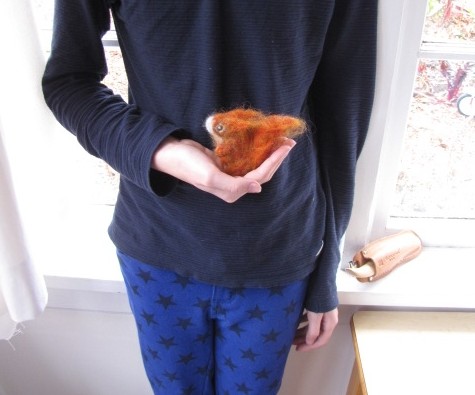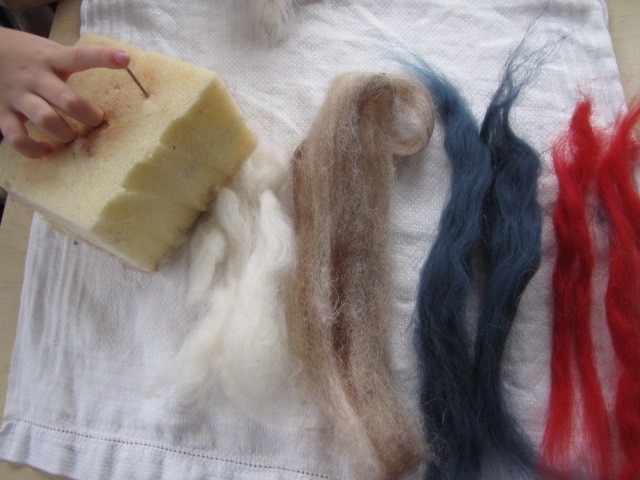Autumn Fires
We’re slowly working on getting out the autumn decorations and switching the Nature Table over from summer to fall. The children have been collecting items from the yard and around the neighborhood. It seems like every time I step outside, I find someone’s little collection of goodies on the front step or back table.
I think some of the nature-mindedness is due to the time of year, but some of it is due to a wilderness study we’ve started:
I’m teaching a class at our homeschool co-op based on the book My Side of the Mountain by Jean Craighead George. It is one of my favorites from childhood. The main character, Sam, runs away from his home in New York to live in the wilderness. Every week at co-op, we’re discussing a few chapters of the book, making crafts that correspond with the chapters, and learning a wilderness survival skill that Sam utilizes in that section of the book.
Bea is the only one of my kids taking the class, but the other children didn’t want to miss out, so each week I’m reading the assigned chapters aloud, and the whole family is learning the skills we’ll test out in class. The hardest part so far has been reading only the assigned chapters and not reading ahead – everyone wants to know what happens next!
After reading our chapters, it was George’s turn to be my kitchen helper and we baked a Sun Cake in honor of the shrinking days now that the autumnal equinox has passed us. (You didn’t know a four yr-old could get so much powdered sugar on the floor and counter instead of the cake but he had fun doing it.)
The cake is a basic yellow butter cake (2 8-inch rounds), with orange glaze and candied orange peel. I would normally put orange marmalade in the middle, but my sister had just brought us back a little jar of wild huckleberry jam from her trip to Glacier National Park, so I used it instead (a very tasty substitution, if I do say so).
While George and I finished up the cake, the older kids watched a few videos on primitive methods of starting fires, including how to make tinder bundles and start a fire with flint and steel. (They already know how to use a bow drill to start a fire thanks to a fews summers’ worth of Trackers camps.)
In our chapters we read aloud today, Sam initially fails at fire-making, only to succeed a few days later. The kids’ assignment is to learn about making a fire without matches and then collect items with which to make a tinder bundle. (At co-op on Friday, the students in my class will try various types of tinder bundles and methods and see if we have the same troubles Sam does, or if we can succeed in catching an ember and starting a fire.)
When the cake was done, we all went outside to collect items we thought would make good tinder. The neighbor boys lent a hand, and the kids gathered everything from pine needles to dry leaves and an old birds’ nest. Bea used her pocket knife to shave off bark curls, and lamented the lack of cattails in the neighborhood, from which we could gather the fluff for excellent tinder.
In honor of our fire-making adventures and the beginning of fall, this Robert Lewis Stevenson poem seemed fitting to leave you with:
Autumn Fires
In the other gardens
And all up the vale,
From the autumn bonfires
See the smoke trail!
Pleasant summer over
And all the summer flowers,
The red fire blazes,
The grey smoke towers.
Sing a song of seasons!
Something bright in all!
Flowers in the summer,
Fires in the fall!
– Robert Louis Stevenson






















































































































![IMG_9938[1]](https://blog.parkrosepermaculture.com/wp-content/uploads/2014/09/IMG_99381.jpg)






![IMG_0441[1]](https://blog.parkrosepermaculture.com/wp-content/uploads/2014/12/IMG_04411-e1417714913458.jpg)
![IMG_0444[1]](https://blog.parkrosepermaculture.com/wp-content/uploads/2014/12/IMG_04441-e1417715500110.jpg)
![IMG_0446[1]](https://blog.parkrosepermaculture.com/wp-content/uploads/2014/12/IMG_04461.jpg)
![IMG_0439[1]](https://blog.parkrosepermaculture.com/wp-content/uploads/2014/12/IMG_04391.jpg)













